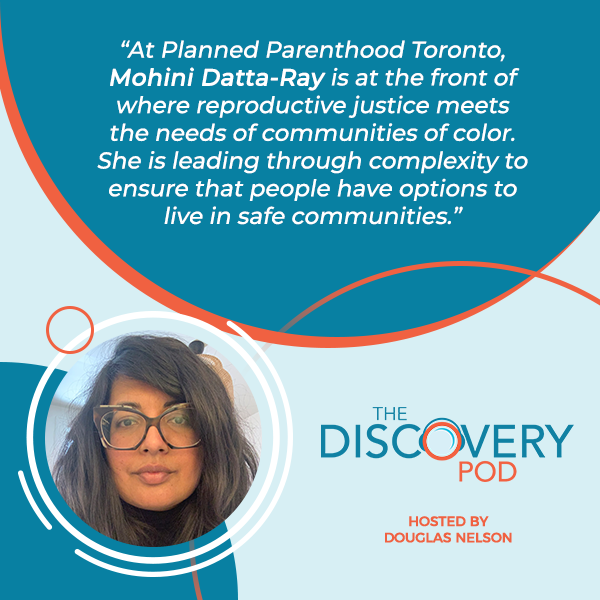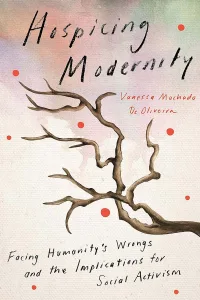
The fight for reproductive justice is an ongoing struggle that continues to face political and philosophical challenges despite the rise of movements in support of this cause. As the Executive Director of Planned Parenthood Toronto, Mohini Datta-Ray is at the forefront of carrying out programs that aim to advance reproductive health and the overall well-being of young people. In this episode, she sits down with Douglas Nelson to share what it takes to sustain leadership in a challenging environment. Mohini lets us in on her experience leading this organization in the current context, where we are seeing the rolling back of reproductive rights in the United States. Leading through complexity, she also talks about serving from the zone of excellence and learning when to hand over the reins when the season for your leadership is over. Join this conversation and find out how a youth-driven, culturally-responsive community health centre overcomes towering issues and moves forward in the name of reproductive justice.
—
Listen to the podcast here
Planned Parenthood Toronto With Mohini Datta-Ray, Executive Director
In this episode, we have a great guest, Mohini Datta-Ray, who is the Executive Director of Planned Parenthood Toronto, a youth-driven culturally responsive community health center that advances reproductive justice, health, and overall well-being for young people. Previously, Mohini served as Executive Director of North York Women’s Shelter, one of Toronto’s oldest shelters for survivors of gender-based violence.
She goes deep into her thinking about leading an organization in transition and those moments of inflection. She spends a lot of time talking about the zones of excellence, competence, struggle, and what it takes to sustain leadership in a challenging environment. If you’re interested in what great leadership sounds like, you’re going to want to read this great discussion with Mohini Datta-Ray. Welcome to the show, Mohini.
Thank you.
It is really great to have you on the show. We’ve got a lot of great questions planned for you. We’re going to have an excellent conversation. Before we jump into that, could you tell us a little bit about Planned Parenthood Toronto, what it does, and who it serves?
Planned Parenthood Toronto is a community health center that serves youth between the ages of 13 and 29. You find community health centers across Canada, Ontario in particular. They consist of primary healthcare. We’re essentially like a family doctor comprised of physicians and nurse practitioners. We have mental health services and case coordination. What makes us a community health center is that there are lots of community programs. Our focus is reproductive health as well as general primary care. We also make sure that we focus on equity-serving communities, queer, trans youth, and racialized youth in an inequitable city, which is increasingly important to do.
One of the questions some of our audience may have is the planned parenthood part of that, which most of us in Canada are aware of as a large healthcare provider in the United States with some significant advocacy muscle behind them as an organization. How does the Planned Parenthood concept relate to the work that you do in Toronto?
Planned Parenthood Toronto was founded by Barbara Cadbury of the Cadbury chocolate family. She was part of the Planned Parenthood Federation of America in the ‘60s. It was 1961. She had some Canadian ties. She came up and, at that time, birth control and disseminating birth control was illegal. It wasn’t quite the second wave. It was still suffragette politics. They came together to try and expand access to birth control in Canada. They formed the Planned Parenthood in Toronto at that time. By 1969, they had established themselves as an organization.
We are located in the same place we’ve always been located while in existence, which is right in the annex. If you know Toronto, it’s right by St. George Station near UFT in a little Victorian house. We used to be called The House. It is to be focused on birth control options and then abortion care when that became decriminalized in Canada decades later and then expanded into a health center and focused on youth health. That’s the legacy. We’ve got philosophical political ties with Planned Parenthoods across the world that we are a community health center with a population-specific focus. We focus, as I said, on reproductive health, sexual health, and education.
It’s a really important mandate. While we don’t have a product endorsement on the show, everybody should probably go buy some Cadbury chocolate.
Also, donate to Planned Parenthood Toronto.
There you go. That’s probably a better pitch. You’re on your game. This is going to be great. You talked about the journey for reproductive rights in Canada. Certainly, in Canada, we’ve been watching the rolling back of those rights in the United States over the last few years. There are now 22 states that ban abortion or impose new restrictions. It is a terrifying time for many people as a result of that. Do you see that showing up in conversations in Canada or any impact on the work that you do on a daily basis?
For sure. This is a well-organized anti-abortion contingent that not only existed but was funded by the American contingent. They know that it’s a different context in Canada, so it’s a different battle and fight. It’s decriminalized or should be decriminalized. In Canada, it means that there are no laws governing it at all so there are no restrictions. What they try and do with the anti-abortion faction is introduce legislation under the guise of protecting women or folks from gender-based violence by trying to make the fetus a person so there are higher criminal charges if you were to assault someone who’s pregnant. This is the thin end of the wedge tactics. We have to be not just vigilant but also help frame for the public what these fights are about and do a lot of education.
In Canada, the issue was not top of mind. The battle is not out in the public, but there are some very serious access issues in Canada. Where it shows up is in provinces like Ontario, which is in violation of the Canada Health Act when it comes to access to abortion. There’s no public real out prior around it because it’s so complicated and boring that people don’t quite understand what the issue is. We know that only 1 in 6 hospitals will provide abortion care in Canada because no Catholic hospital will touch it. That’s allowed, even though that’s in violation of the Canadian Health Act. We know that most abortion providers are within 100 kilometers of the US border in Canada. It means anywhere North of that, it’s almost impossible to get an abortion without traveling for hundreds of kilometers.

Planned Parenthood Toronto: We have to be very vigilant but also help educate what these fights are actually about because, in Canada, the issue is not top of mind. The battle is not out in the public.
We know that lots of physicians are anti-abortion quietly and will put up barriers or make it really difficult to access them. We also know that there are over 88 anti-abortion MPs in the federal parliament. They are funded by anti-abortion groups across the border and within Canada. We know that they’re using strategies that they’re learning in the US like taking over school boards and city council, trying to run candidates, etc. To really shift the conversation in the Canadian context, they know that Canadians don’t have the appetite for rabid anti-abortion politics so they try quiet tactics to shift the conversation and make it even less accessible than it is now.
You delivered that response as this is just a matter of fact. When I hear that, it makes me so angry. How do you, as a leader, balance genuine outrage with the practicality of continuing the conversation and vigilance that you were speaking of?
It’s a developed skill. It’s something you have to develop within yourself to effectively lead, as you said, equity deserving outrageous work. Like me, I am trying to keep it light, but I am also outraged by the reality of it. If you stay in that outraged all the time, you will burn out and turn brittle. It takes away your ability to be creative in the face of towering almost impossible seeming issues. It’s important to find humor in the work that you do and small victories. It’s really important to have a community around you. I have mentors, lateral peers, and youth mentors who are younger than me and more junior than me. I want to use organization and I’m no longer a youth.
If you stay in that outrage all the time, you will burn out and you will turn brittle. Brittle takes away your ability to be creative in the face of really towering, almost impossible issues. Share on XAlso, teaching me and showing me what the issues are that are important to them, and those shift from generation to generation. My outreach and my approach are reflective of the generation above me who taught me but are not necessarily everything and everything that needs to happen in this moment. That community is important, but a sense of humor is around it. It’s taking the air out of some of how ludicrous and ridiculous these fights are. It’s helpful because it allows you to focus without completely burning out yourself, which is something that I see happening around me.
Across the social profit sector, it’s the issue of burnout at the level of executive director and CEO. In our day-to-day work here at The Discovery Group, we talked a lot to leaders who are like, “I’m finding it hard to hit that second gear that usually kicks in when I get tired. It’s not there. It feels like it’s harder these days.” What you’re sharing there is that connection, both the purpose, to those that you serve, to peers, and to mentors. That sense of community is so important for leaders to be able to keep focused on what they need to be doing and keep the energy to do it well.
We might talk about this in more detail, but it’s also about knowing when it’s time to move on. I have had a career where I don’t think I’ve been anywhere for more than five and a half years. That has been a conscious decision to know when it is time to hand it over to someone else who needs to then take the reins to lead whatever movement building we’re doing into the next phase. Often, metaphors are used for a flock of birds.
If there’s only one bird ahead of that flock, and I know that’s not how birds fly, but they take turns because the head of the flock is going to exhaust itself very quickly. You take turns and you give each other breaks, but you make sure that you’re building that around you. That’s an important thing for leaders. We’re not always allowed the freedom to do and we need to take up that space. Also, teach our boards that that is not acceptable but that’s something you need to do.
I really like that. One of the questions that I often get asked by CEOs or people who are working with us is, “How did you know it was time to move on when you were a CEO?” My advice is, “You know.” It’s unambiguous. You have that feeling first when it’s time to go. I feel that in the two roles that I exited. I remember the moment when I was like, “This is it.” I didn’t leave the next day, but this is the time that it gets transitioned. How have those moments arrived over your career and said, “It’s time for another bird to lead this walk?”
It sometimes comes on a little bit quickly like a little feeling in the belly, and sometimes it’s very obvious. In either case, it’s been that I no longer feel like what I bring to this organization is what it needs. Somehow, what I’m getting from this organization, instead of being fueling something, is starting to exhaust me in a way that feels chronic. It doesn’t feel like it’s going to shift or that there are any easy or obvious solutions that I should even be looking for. It feels like this was a phase.
One of my mentors always talked about leaders for different seasons and seeing organizations as going through seasons. Also, holding your connection to an organization both as a sacred thing. You’re there and you were being entrusted with a lot of resources by the community and a lot of trust from your community to be able to do this work. Also, holding that relationship lightly to have the space to know intuitively when it’s time to move on. In any case, it comes from that sense that I’m not the right person to do this. I’m not in that zone of excellence anymore in relation to that work.
There is such a genuine humility and realization that your season may have come or may have passed. I do think there is a lot that’s very healthy about leadership transition or sector. Not every 2 years but every 18 months. That speaks to the crisis. I do think there’s something unique and special about those leaders who not just hold on but lead their organizations for 15 to 20 years. It is unique to them and their environments, but what we see more likely or more frequently is that a 5- to 8-year window is the sweet spot for people to move organizations forward in a meaningful way.
Some of it is also circumstance and coincidence. Maybe it’s the time in which I started my own leadership journey. I came to now three organizations where they were in moments of transition or needed to do something transformative. That is where I found my wings at the front of the flock. Sometimes, when that moment of transformation realizes itself, that next phase might not be yours to lead. It might be someone else’s to do and to go deeper. I don’t know if that’s going to be the same story that I’m going to have at Planned Parenthood Toronto. I don’t have five years and I’m out of a plan, but if there is a large transformative moment, sometimes that’s also when you know that it’s somebody else to take that new thing and go deeper with it.

Planned Parenthood Toronto: If there is a really large transformative moment, sometimes, that’s also when you know that it’s somebody else to take that new thing and go deeper with it.
One of the phrases we often hear is, and I’m sure you’ve heard this too, people are like, “I’m not a sustainer. I’m more of a builder. I don’t want those moments of inflections and I don’t want to sustain it.” The reality is I’ve never met a leader who’s like, “I’m good. I’m going to keep this where we’re at.” Certainly, it’s not in our sector or these purpose-based organizations. It is about social good and improving the condition of life, existence, and experience for the communities that we serve. It’s never on neutral like, “We’ll hang out here and go to the speed for a while.”
Every leader is invigorated with that energy to take things to another level and move things forward. For some leaders, it’s best if they hand the baton on or fly in the back of the pack for a while. One of the things you mentioned there was your zone of excellence. I know you use your zone of excellence competence and zone of struggle and think about where you’re spending your time as a leader. How do you use that framework on a day-to-day basis in your role at Planned Parenthood Toronto?
I was lucky enough to be invited to a complexity fellowship for leaders in this moment of rapid exponential change that we find ourselves in. That’s where I was introduced to this idea. It was something that the fellowship facilitators were trying to get us to think about as leaders leading through complexity. It was like, “What does it mean to be in a zone of excellence?” One of the characteristics that have stuck with me about knowing when you’re in that zone is being able to intuitively ground into a place, at least for me, where I am identifying those levers of change that are not the most contested levers.
You’re finding ways of making significant change happen through a creative process that’s coming through process where you synthesize all of this information that you get from your community, all the research that you’ve done, and what you know about that needs to happen but also able to find creative solutions. I find myself at my happiest when I can get there, and I know that there’s a flow that happens versus in the zone of competence where I know and which is where I find myself most days. We mostly find ourselves where you know you’re good at this and it needs to happen. I know all of the HR operational work at my organization that needs to happen. I’m competent at it. Is it where I’m at my most excellent?
Being in that zone of genius is when you're finding ways of making significant change happen through a creative process. Share on XIs it where there’s the flow, creativity, shifting, and transformative work? That’s probably not where that’s happening, but you can’t always only be in your zone of excellence too. It’s a bit of a floating back and forth. I will say that shifting from a gender-based violence sector where I was and into Planned Parenthood now, I am quite conscious of where that shift hasn’t happened yet. There’s something about working in my previous sector where we were working with women and children mostly who would experience gender-based violence and were running a shelter. I got to rebuild a shelter from the ground up. I got to revise it and do it with a community. We raised $23 million in under two and a half years.
We built this 24,000-square foot completely accessible trauma-informed, child-friendly, pet-friendly, and first-of-its-kind guarded shelter in Toronto that tried to meet everything that survivors had told us over decades with all of the research and best practices, and the things that were like dreams to me. It’s a beautiful space, and then the pandemic hit two and a half weeks after we reopened. On one hand, I’m suddenly no longer in my zone of excellence. I’m in my zone of competence and probably struggle, trying to run this place now in the middle of spikes and gender-based violence in the pandemic of 2020, 2021, 2022, and continuing on. It has been brutal years, but one thing we know is that there was no COVID transmission in that shelter at all because of the design of the space.
It was so centered on human dignity. We ran a school out of there. There were gardening and dance programs. It was a lovely experience as well, but I reflected on what it meant to fundraise between these two sectors and what it means to have a narrative that lands for the community. When I was in the gender-based violence space, we got to fundraise and use the narratives and stories we had about children and pets. That was guaranteed to get money through the door because the community rallied together to support children and pets.
If we talk about adult survivors of violence, less so. When I’m here and I’m talking about abortion care, reproductive justice, climate justice, poverty, and all of the things that are impacting youth, it’s very difficult to fundraise. Also, realize your competency and what grabs the attention of the public when you’re trying to run organizations. It is also something that we have to consider. I’m finding that struggle between these two organizations.
As someone who’s accomplished so much in your last organization, there’s always such a steep learning curve when you move to a new organization and spend time in that zone of struggle. There’s some beauty in learning new things about yourself as a leader and challenging some assumptions you may have made from other places. For many days, it’s hard. How do you maintain that openness to learning that comes from the struggle and protect yourself from the exhaustion that also accompanies the struggle?
I don’t know if I do that perfectly. I’m exhausted on many days, as most of us are. We are looking at very complex issues in a way that we have not had to, and it’s exponential. There is that personal self-care that every leader needs. We also have to be very realistic that these are different times. That has helped us accept what complicated complex crises we are in. People call it the polycrisis. Everything seems to be falling apart at the same time. It is ironically or maybe helpful rather than being in denial that the same old strategies are going to work, looking for unusual solutions, and listening differently. There is this book that I’m reading. It’s almost like a workbook, and it’s called Hospicing Modernity.
It’s talking about modernity, what it is, modernity being this idea of continued progress, and everything is going to march towards this place of improvement and there is a blanket culture, economy, and structure that is going to take over the world. That’s what colonialism has ridden on the back and that’s the logic for imperialism. It’s the logic for keeping systems the way that they are. That is what we’re up against when we’re unable to solve these complex problems because while we are here doing direct service work, there are large structures that keep us spinning and keep these issues alive that are refusing to shift. Knowing that is also important and advocating. It is holding both things in two hands the direct service work, that deep advocacy work, and being very politically savvy.
It’s important for us to acknowledge and racialize leaders. That is in a separate colonial country. I’d be characterized as someone from an equity-seeking group or marginalized, but I also come with a lot of privilege. My family came to Canada in the ‘80s as part of a large migration of various skilled labor and executives, particularly from the mining and extraction industries. I come from a family that came with a lot of economic stability. Not a ton of wealth but stability. My father was part of the mining industry. In a social profit sector, it’s almost taboo to talk about.
I have had to be in a place where I’m very exposed to what that has meant, and that has provided me with a lot of information about Canada, Canada’s economy, and Canada’s role in the world. When we are trying to solve these problems on the ground, we must be very mindful of what those larger structural factors are that are leading to the crisis that we are in now. Being realistic is very important to keep me from burning out.
It’s always fascinating to me to get to talk to leaders of service provisioning organizations. There may be a lineup of people outside your door on any given day or maybe every day. As the leader of your organization, it’s how you resource the clinic and how you make the health center function, which is not an uncomplicated business. There’s a lot of attention and focus required to do that well.
A lot of the people that are coming through the doors have a lot more going on than just the health questions that they’re coming to you for and that polycrisis that you referring to. How do you find that balance between being able to make sure that you’re able to meet the needs as a health center and as the family doc for the community and those larger systems issues that you were describing?
I’m so glad you asked that. I came to Planned Parenthood Toronto because I felt that my time to transition out of my last role had come, but also because I was so excited about being able to start in this role. Planned Parenthood Toronto hosts a very beloved dear place in the hearts of many folks in the city. It has a lot of credibility as an organization. It’s very high and excellent service, delivery, and programming in the community, so there’s lots of credibility and multiple communities. That was exciting to me because all I saw when I saw this organization was massive potential. It has massive potential to actually address some of these very complex issues while providing service provision on the ground.
I’m very lucky that I’m a supportive politically savvy board of directors who do understand what I’m talking about and are supportive or at least willing to learn together around what we can do. Thankfully, we’re right at the point where it was strategic planning time. We had a steel strap plan and we looked at our foundational statements, values, and purpose. Planned Parenthood Toronto had a lot of choice-based language that gave it a lot of meaning prior to this. That’s coded for being pro-choice, and it’s around abortion access. We need to expand out. Keeping abortion is an absolute pillar and cornerstone.
We adopted the principles of reproductive justice, which is a concept that was established by Black feminists and indigenous feminists in the US to understand that reproductive justice meets the needs of communities of color much more realistically and expansively than abortion. It’s because abortion is one option through many different choices, but it’s also not accessible for everyone, and it might not be everybody’s first choice. If we’re talking about communities, we also need to make sure that folks have the option to live in safe communities that are not experiencing levels of pollution that make life impossible with economic degradation and racism. All of the things that are social justice priorities are tied to reproductive health and reproductive rights.

Planned Parenthood Toronto: We all need to make sure that folks have options to live in safe communities.
We shifted our framework, which is a big change for an organization. That also has an accountability to racialize communities in a way that we hadn’t before. The other pillar that we wanted to make sure that we included in our strategic plan was the used features. We are a youth organization. If we’re a youth organization in a polycrisis, it means that we have to prioritize youth, their futures, and their priorities. What they need is where we need to go as opposed to us continuing to provide direct service provision without a lot of reflection on how we are meeting these wildly complicated and complex needs we are presenting.
What’s an example of something that you’re doing differently now as a result of that shift in focus when you’re thinking about the needs of the 13 to 29-year-old community you serve?
Let me think about something tangible. Here’s something very simple. Toronto is increasingly a completely inequitable city. It is getting so impossible for anyone who isn’t, at least upper middle class, able to live in the city comfortably to own or rent. It’s outrageous to see it. Even staff at organizations were working jobs and paid at rates that I used to get paid years ago when I was a frontline staff and was able to comfortably afford an apartment. I was a young person in the city and was able to live here. We’re seeing that this economic inequity is pushing youth out. It’s like a doughnut. It is the outer burbs of the city or even outside of the suburbs. Planned Parenthood Toronto never had to think about that.
We always went to provide community programs wherever we were invited, and that was during the beginning and end of it. If schools and libraries invite us, we go. As part of our reproductive justice and youth futures reframing, we are spending a lot more time looking at lots of great data that tells you where the inequities in the city are showing up and where racialized communities are living, forced to live, or moving to where poverty rates are higher. We are making sure that we are not just prioritizing those neighborhoods, but if those are areas that we don’t have relationships with, we are building relationships in the community and seeing what we can do differently.
We’re accountable to a community first in order for us to be relevant to this community. As wonderful as Planned Parenthood Toronto is, there has been a long-standing history of us only being relevant to middle-class White young folks like university students and shifting that focus. The other thing I will say we’ll see this as an impact is we’re funded $74,000 to provide healthcare to non-insured youth. Most of that goes to abortion care. Through the pandemic, we’ve been spending $500,000 in providing abortion care, and it’s mostly to non-insured racialized youth who are students. A lot of whom are international students who are coming here on programs that are fraudulent. We have to pick up those pieces.
Looking at this issue differently, we have our first post-abortion support group that is going to focus on the communities that are accessing this program, and that means racialized communities. Making those decisions is new for Planned Parenthood Toronto. We started hiring only racialized physicians every time we had a vacancy, which was new for the organization that had an almost entirely White clinician team.
Also in healthcare, which is profoundly racist, especially reproductive healthcare. There’s so much racial trauma when it comes to health and reproductive health in racialized communities, including eugenics, four-star organizations, and not believing Black women when they’re talking about their own pain or a childbirth experience. That itself was a huge barrier for folks, even accessing us despite we are well-intentioned. We’re a very well-intentioned organization. What do we do with our intentions? We commit to what we believe in.
There is so much racial trauma when it comes to reproductive health. Share on XIt’s a bold path you’re describing, for sure, with a lot of purpose behind it and work to do ahead of you. We were introduced through a mutual friend, Sharon Avery, at the Toronto Foundation. One of the things I really appreciate about Sharon is her ability to bring people together to convene conversations and conversations that often turn into action. It’s one thing to talk about it.
Nothing to do something about what you talked about and Sharon is usually one of the people saying, “What are we going to do about it? How are we going to make things better?” You mentioned having a community of peers, youth mentors, and senior mentors to yourself. When you’re having a challenging day, like you’ve got an issue, you’re excited about, or you get to move forward on a particular front, who do you call first, as a leader, to either restore your spark or to amplify that spark into a flame?
It depends on what the issue is but of course my partner. When it comes to this work, I do have a community of special three racialized women who have all been my mentors there and continue to be my mentors. They’re a generation ahead of me, have done incredible work in the community, and have pushed agendas forward in ways that are profound. One is Hazelle Palmer, the CEO of Sherbourne Health.
She used to be the Executive Director at Planned Parenthood Toronto. We met at the AIDS Committee of Toronto. I followed her around in a particular way but we continue to be such good friends, and then there are a few other racialized women who understand the joy and the toll of being a strategic racialized woman doing work. That is both direct service and has to be very strategic and savvy politically to push agendas forward that are resisting being pushed at all.
Given the daily tension of the immediate versus the system change that you’re working on, what are you looking forward to?
What I’m looking forward to when it comes to Planned Parenthood Toronto is feeling like we are finally resourced in a way where we are able to do both of those things without burning out folks by adding more and more to their plates. Healthcare has been decimated over the last few years and even more so as we’re seeing an increased privatization. Let alone support for the growth of letting healthcare-providing organizations, especially community-based healthcare organizations collapse, and that opens the space for privatization. We’re resisting that. I did start a fundraising department at Planned Parenthood Toronto, which we never had before.
I’m looking forward to that to be able to bring in much-needed funds to stabilize the organization so that we can do both of these things well. When I came here, one of the things that was incredible was how resourceful this organization is. However, they were running the front reception of the clinic through a staffing program at the city of Toronto with staff that was subsidized by the city, and you lost those staff every eight months. The work that we do is so vast. I’m looking forward to the days when that is stabilized so that we can all be in that zone of excellence in a way that we’re not grinding our gears all the time.
Thank you for sharing that. I would reflect back on the part of your answer to what you’re looking forward to a few more months in that zone of struggle. There’s a little bit more work to do there. I look forward to staying in touch and hearing what the transition to the zone of excellence feels like at least in the months ahead. Mohini, I thank you so much for making time to be on the show. I have so much admiration and respect for the work that you and your colleagues do. I really appreciate you sharing your leadership lessons with our audience.
Thank you so much. Thanks for having me.
Important Links
- Planned Parenthood Toronto
- Planned Parenthood Federation of America
- Hospicing Modernity
- Toronto Foundation
- Sherbourne Health
- AIDS Committee of Toronto
About Mohini Datta-Ray
 Mohini is the executive director of Planned Parenthood Toronto, a youth-driven culturally-responsive community health centre that advances reproductive justice, health and overall well-being for young people. Previously, Mohini served as the Executive Director of North York Women’s Shelter (NYWS), one of Toronto’s oldest shelters for survivors of gender-based violence and Director of the Provincial Women and HIV/AIDS Initiative.
Mohini is the executive director of Planned Parenthood Toronto, a youth-driven culturally-responsive community health centre that advances reproductive justice, health and overall well-being for young people. Previously, Mohini served as the Executive Director of North York Women’s Shelter (NYWS), one of Toronto’s oldest shelters for survivors of gender-based violence and Director of the Provincial Women and HIV/AIDS Initiative.




